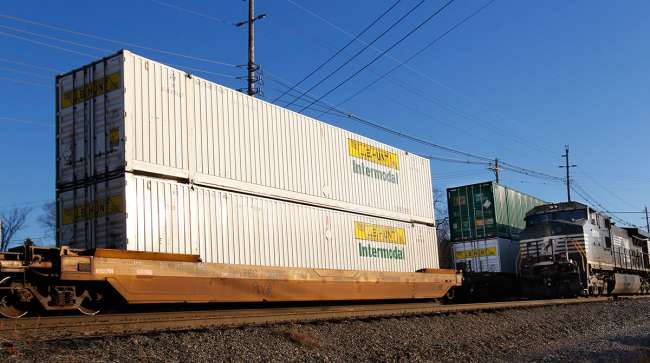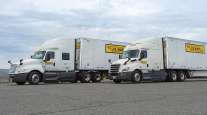Staff Reporter
Trucking Companies Bet on Intermodal Growth

[Stay on top of transportation news: Get TTNews in your inbox.]
Trucking companies are further expanding into intermodal operations for new avenues for growth.
“What we have seen, probably over the last few years, was market shares shift away from domestic intermodal to truck and international intermodal,” Citigroup analyst Chris Wetherbee told Transport Topics. “I think there’s an expectation for a few reasons that as this year plays out and we go into next year, that there is the opportunity for market share to shift back to domestic intermodal, supported by the rails, that will generate growth for all of these companies.”
Wetherbee noted the most important drivers of intermodal growth are supply chains unwinding, fuel costs and the environment. Environmental, Social and Governance (ESG) initiatives have become more popular due to customer demand and government regulations that have pushed more carriers to consider ways to be carbon neutral and fuel-efficient.

Seidl
“You have the expectations that the railroads are going to start getting their operational act together after, let’s face it, over a year of disappointing results,” Cowen and Co. analyst Jason Seidl told TT. “Then, I think, there’s been a big push with companies looking at their own ESG scores.”
J.B. Hunt Transport Services plans to grow its intermodal fleet by 40% to as many as 150,000 containers in the next three to five years as part of a joint effort with BNSF Railway Co. Schneider National on Jan. 19 announced plans to expand its intermodal service by moving its primary Western rail partnership to Union Pacific Railroad.
“It’s clear that intermodal is an important growth engine, both for the railroads and as a method of how the shippers want to move their freight,” Bank of America analyst Ken Hoexter told TT. “And so, the carriers are trying to get improved service and improve fluidity in their network.”
It’s clear that intermodal is an important growth engine, both for the railroads and as a method of how the shippers want to move their freight.
Ken Hoexter, Bank of America analyst
In October, Hub Group announced plans to expand its refrigerated intermodal container fleet.
Knight-Swift Transportation Holdings cited plans Jan. 26 to position its intermodal business for continued growth by increasing its container count by 2,000.
“When thinking about the future trajectory of the intermodal market, we believe the sector is well-positioned to see a reacceleration of growth in the years ahead from a combination of the economic value proposition, an ongoing shortage of truck drivers, normalizing rail service, the potential for higher fuel prices and an enhanced focus on ESG,” Stephens Inc. analyst Justin Long said in a statement to TT.

Long
Hoexter noted that in the past few years intermodal growth decelerated from previously outpacing the market as railroad providers worked to refine and refocus how their network was structured to increase profits and improve service.
“As we went through that process, we’re now at the point where they’re looking at the improved service capabilities and capacity to now refocus on growth,” Hoexter said.
Stifel Capital Markets analyst Bruce Chan noted diversification is a big reason why some truckload carriers are investing in the intermodal space.

Chan
“I think coming off of a very profitable and strong market for a lot of the truckload carriers, they’ve looked at ways to reinvest and redeploy capital,” he told TT. “I think they’ve looked at other ways to diversify their revenue streams, other service lines that are complementary to ones they offer, whether that be final-mile, LTL, dedicated or intermodal.”
Seidl noted not only is there the potential for carriers to grow with the railroad companies, intermodal provides a hedge to the base business.
“They’re investing in the physical assets, the containers themselves, and owning the physical asset right now has been proven to be better than not,” Seidl said. “Take [Union Pacific] for example, you saw some of their announced surcharges, up to $4,000 a container for people who go over their weekly limits. That’s if you use their equipment.”

Wetherbee
Wetherbee noted if congestion unwinds and supply chains become more balanced, then shippers gain breathing room to rebalance between cost and service. He noted intermodal oftentimes does well in that environment.
“Shippers have been in a rush to get product to market,” Wetherbee said. “When you’re in a rush, you tend to opt for the fastest service. And sometimes that service may be more expensive, but you need to do what you need to do because you don’t want the business to fail. And so that has really favored truck over the course of the last few years.”

Host Michael Freeze discusses the future of tire maintenance with Yokohama's Tom Clauer and Goodyear's Austin Crane and Jessica Julian. Hear a snippet above, and get the full program by going to RoadSigns.TTNews.com.
Stifel analyst Bert Subin pointed out the growth potential also depends on the company. Knight-Swift probably will see marginal growth to the overall business because intermodal is such a small piece. Schneider could see a more noticeable impact because its intermodal operations is a larger part of its business.
“In terms of earnings power, I think it is certainly a positive for Knight-Swift just by improving the business,” Subin said. “But the growth from it will take a while to be super meaningful.”a
J.B. Hunt ranks No. 4 on the Transport Topics Top 100 list of the largest for hire-carriers in North America. Knight-Swift is No. 6, and Schneider is No. 7.
Want more news? Listen to today's daily briefing below or go here for more info:




